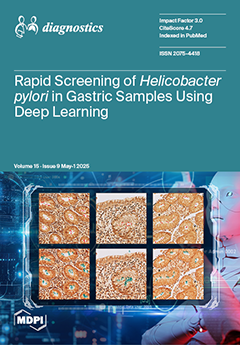Background/Objective. Toxin-producing strains of
Clostridioides difficile (
C. diff) are the most commonly identified cause of healthcare-associated infection in the elderly. Risk factors include advanced age, hospitalization, prior or concomitant systemic antibacterial therapy, chemotherapy, and gastrointestinal surgery. Patients with unspecified and new-onset diarrhea with ≥3 unformed stools in 24 h are the target population for
C. diff infection (CDI) testing. To present data on the risks of laboratory misdiagnosis in managing CDI.
Materials. In two general hospitals, we examined 116 clinical stool specimens from hospitalized patients with acute diarrhea suspected of nosocomial or antibiotic-associated diarrhea (AAD) due to
C. diff. Enzyme immunoassay (EIA) tests for the detection of
C. diff toxins A (cdtA) and B (cdtB) in stool, automated CLIA assay for the detection of
C. diff GDH antigen and qualitative determination of cdtA and B in human feces and anaerobic stool culture were applied for CDI laboratory diagnosis. MALDI-TOF (Bruker) was used to identify the presumptive anaerobic bacterial colonies. The following methods were used as confirmatory diagnostics: the LAMP method for the detection of Salmonella spp. and simultaneous detection of
C. jejuni and
C. coli, an
E. coli Typing RT-PCR detection kit (ETEC, EHEC, STEC, EPEC, and EIEC), API 20E and aerobic stool culture methods.
Results. A total of 40 toxigenic strains of
C. diff were isolated from all 116 tested diarrheal stool samples, of which 38/40 produced toxin B and 2/40 strains were positive for both cdtA and cdtB. Of the stool samples positive for cdtA (6/50) and/or cdtB (44/50) by EIA, 33 were negative for
C. diff culture but positive for the following diarrheal agents:
Salmonella enterica subsp.
arizonae (1/33, LAMP, culture, API 20E);
C. jejuni (2/33, LAMP, culture, MALDI TOF); ETEC O142 (1/33), STEC O145 and O138 (2/33,
E. coli RT-PCR detection kit, culture);
C. perfringens (2/33, anaerobic culture, MALDI TOF); hypermycotic enterotoxigenic
K. pneumonia (2/33) and enterotoxigenic
P. mirabilis (2/33, culture; PCR encoding LT-toxin). Two of the sixty-six cdtB-positive samples (2/66) showed a similar misdiagnosis when analyzed using the CLIA method. However, the PCR analysis showed that they were cdtB-negative. In contrast, the LAMP method identified a positive result for
C. jejuni in one sample, and another was STEC positive (stx1+/stx2+) by RT-PCR. We found an additional discrepancy in the CDI test results: EPEC O86 (RT-PCR eae+) was isolated from a fecal sample positive for GHA enzyme (CLIA) and negative for cdtA and cdtB (CLIA and PCR). However, the culture of
C. diff was negative. These findings support the hypothesis that certain human bacterial pathogens that produce enterotoxins other than
C. diff, as well as intestinal commensal microorganisms, including Klebsiella sp. and Proteus sp., contribute to false-positive EIA card tests for
C. diff toxins A and B, which are the most widely used laboratory tests for CDI.
Conclusions. CDI presents a significant challenge to clinical practice in terms of laboratory diagnostic management. It is recommended that toxin-only EIA tests should not be used as the sole diagnostic tool for CDI but should be limited to detecting toxins A and B. Accurate diagnosis of CDI requires a combination of laboratory diagnostic methods on which proper infection management depends.
Full article






